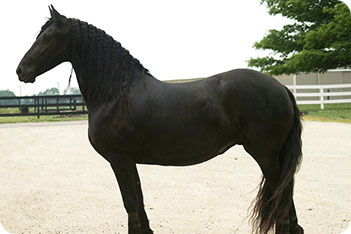
Horseback Riding - Trot
Horse Back Flatwork
From: Equestrian and Horse | Horseback Riding
See also: Mounting | Position | Lunging | Jumping
Dismounting

Flatwork Paces - The Trot
Trotting
The next pace up from walking is trotting. This is a two time rhythm which means that the horse moves its legs in diagonal pairs, for example when the near hind and off fore are elevated off the ground, the off hind and near fore will be on the ground supporting the horse and propelling them forwards.
Types Of Trot
- Working trot
- Collected trot
- Medium trot
- Extended trot.
Asking For Trot
- To ask a horse to trot on, first preparation of both horse and rider is required. This involves the rider checking their position is correct and that they are ready to move on.
- The rider, keeping their heels down and lower leg in position on the girth, gently squeezes inwards.
- At the same time the rider while looking straight ahead, softens the rein contact to allow the horse to move forwards into the trot.
- Once in trot the rider needs to remain tall, and be sitting equally on both seat bones with the seat and upper body square in the saddle, and let their body stay relaxed and moving with the horse, after a few strides of sitting the rider should go into rising trot.
- The rider should have a soft and elastic rein contact, allowing their hands to move freely with the movement of the horse. and with no tension throughout the rest of the riders body either.
- The whole of the riders inner leg should remain in close contact with the saddle and side of the horse, with the lower leg gently squeezing to maintain forward momentum.
Types Of Trot
The two types of trot are rising trot and sitting trot.
- Sitting Trot
Sitting trot is done for the first few strides of trot to enable the rider to relax into the rhythm of the horse, then rising trot should begin and it is also used as an aid for canter. Sitting trot enables the rider to remain in close contact with the horse and when both horse and rider are warmed up sitting trot can be done all the time as it helps the rider to feel what the horse is doing underneath them especially when riding lateral work. - Rising Trot
Rising trot is where the rider rises up and down in time with the horses two time movement, therefore making the rider rise up when one set of the horses legs are suspended in the air and sitting down when that pair of legs hits the ground, depending on which rein you are on will dictate which pair of the horses legs you should be sitting too, this is known as riding to the correct rising trot diagonal.
Faults When Trotting
- Common faults of rising trot are tipping forward, which unbalances both rider and horse,
- tensing up though the back therefore not remaining supple,
- sitting down heavily into the saddle which shows that the rider is unbalanced and makes for a very uncomfortable trot for the horse,
- looking down when in the trot and not forwards and ahead which will also encourage more tipping forwards and rounding of the shoulders.
- Using the rein for balance instead of the riders own body and position.
- The lower leg should remain on the girth area of the horse with the heel down, if the heel comes up then the rider is gripping up with their knee and balancing more on their toes than on the ball of their feet, care must be taken to try and use the riders whole inner leg for balance and security.
- Common faults of sitting trot are tensing up through the riders back, this causes the rider to brace themselves against the horse and can cause the rider to bounce a little in the saddle. By not relaxing into the trot will in turn also cause the horse to tense up through their back.